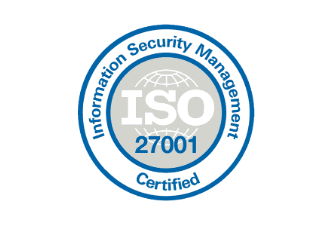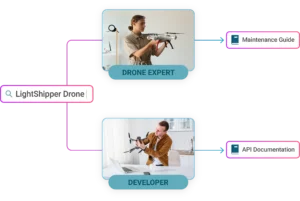In today’s digital age, tech companies understand that documentation is necessary for their business and expend significant time and money on its production and maintenance.
As with any technology, choosing the right Content Delivery Platform (CDP) can be overwhelming. Expectations are higher than ever – customers want a tool that is cost-effective, and seamlessly integrated into their existing IT landscape, with enterprise-grade security and scalability.
Finding a CDP that meets all these criteria is a challenge, but we’ve unraveled the capabilities you need to look into for your next tool.
Here are the 10 essential features for your Content Delivery Platform:
- Out-of-the-Box Portal
- Fully Configurable Portal
- Multisource and Omnichannel Publishing
- Relevant and Personalized Search
- Generative AI Applications
- Interactive User Experience
- Native mobile experience
- SEO Capabilities
- Deep Content Analytics and Reporting
- Robust, Top-Notch Security
1. Out-of-the-box portal
Any company selling software or hardware products will need a documentation portal that will serve its users with the most up-to-date and intuitive content. Documentation portals are secure, digital hubs that let your users access relevant company content (i.e. technical documentation, knowledge base articles, FAQs, installation guides, etc.) from a single source. Portals put your customers in the driver’s seat, permitting them to search for documentation, follow updates, interact with existing content, and submit requests.
Best-in-class Content Delivery Platforms must provide an out-of-the-box portal that can be set up with minimal effort to create and deploy engaging content experiences for all types of users.
Check what your CDP’s portal offers by default (i.e. access right management, search capabilities, page reader, multilingual user interfaces,…). Then, investigate the deployment process: will it take hours, days or months to implement a standard version of your future documentation portal?
2. Fully Configurable Portal
It’s simple, when customers have the freedom and flexibility to configure their product without requiring IT or vendor services, they save time and money. A Content Delivery Platform should allow you to customize your portal design to adapt to your branding. With full autonomy, create the user experience that aligns with your business. Ask if you can:
- Personalize the layout and branding elements
- Create as many pages as you need
- Configure the search and results pages
- Localize your portal
- Make it easily available for mobile
- Do it all with an intuitive low-code editor
- Make sure you’re in control!

3. Multisource and Omnichannel Publishing
The reality is that today’s product content is authored by many people in many departments using different tools. While documentation teams favor authoring tools like a CCMS, developers like to write in Markdown and marketers draft Word documents or create brochures in Photoshop. Find a tool that has ready-to-use integrations and can easily connect to your existing writing systems to ingest content in its native format.
In parallel, your Content Delivery Platform should serve as an intermediate layer between content sources and content-consuming applications. That way, your CDP prevents complex content silos when businesses implement new user endpoints.
By choosing a solution that works effortlessly with your existing tools and platforms, your team will publish their product and technical documentation seamlessly as often as needed and won’t have to worry about content unification and lengthy formatting. Also, users will receive a consistent, efficient content delivery experience.

4. Relevant and Personalized Search
Web search engines like Google have set high standards for search performance. Modern information search has accustomed us to intuitive access to relevant, up-to-date, and contextual information directly from our most convenient digital channel, app, or tool in use. To that point, 71% of customers expect personalized enterprise experiences and 76% express frustration when they don’t get it.
A great Content Delivery Platform should provide a powerful search engine that enables efficient self-service, customer autonomy and drives product adoption.
The average enterprise search engine is not enough to provide fast answers to users’ complex product questions, so make sure that your CDP’s search engine meets the following requirements:
- leverages powerful linguistic models with proven performance on large documentation corpus
- learns from the user and improves the relevance over time
- contextualizes and personalizes results depending on the situation (i.e. in-product help contextual search)
5. Generative AI Applications
A list of must-have features isn’t up to date without discussing AI applications needed to enhance your user experience and boost key metrics.
- Content Experience: Help your users engage more deeply with your portal content. With GenAI, generate content based on their needs: summarized documents, product knowledge quizzes, explanations breaking down code functions, lists of maintenance tools needed for a procedure.
- RAG Chatbots: AI-powered chatbots respond to customer queries in such a natural, conversational matter, users will think they’re speaking to a human agent. Chatbots with Retrieval Augmented Generation, or RAG, capabilities, provide accurate, and up-to-date answers based on your internal product documentation.
- Recommendation Systems: Use Machine Learning algorithms to study user preferences and search patterns. This results in personalized content recommendations. Different solutions use various filtering algorithms (collaborative, content, or hybrid filtering) to decide which content to suggest.
6. Interactive User Experience
The right CDP will take you beyond one-way static publication and help you interactively connect with your users.
Get a solution that lets them bookmark preferred sections, share their own knowledge through comments, and build their own dynamic books. Additionally, permit users to leave feedback, providing a direct line of communication between your technical writers and the people consuming their content.
Finally, make sure you can customize your user experience by hand selecting the features you need: too many options may clutter up your user interface. Define what makes sense in your situation and to your users.
7. Native Mobile Experience
Without the right technology, users who work in the field or have to move around onsite are hampered by inefficiencies. To ensure proper access to product documentation, they need an easy-to-use solution that is responsive for any device. 81% of employees access technical documentation from their mobile devices but 43% of the workforce lacks this mobile access.
Your CDP must render content in any format (i.e. text, 2D, 3D, multimedia) across all devices to guarantee technicians and mobile-first users receive clear instructions for consistently applied procedures.

8. SEO Capabilities
Companies succeed in improving their corporate website SEO yet miss opportunities to enhance product awareness and brand visibility with product documentation. Unlike corporate websites, an online documentation portal provides either public information or confidential resources. If your content is public, you’ll want to make sure search engines like Google or Bing can find it to generate organic traffic. Ensure your CDP gives you the possibility to activate and customize the way your content is exposed.
Check whether you can:
- Define document titles by adding metadata, such as version or product, in the title
- Generate multiple site maps when you have too many documents
With document metadata management and site map generation, documentation portals help search engines index your content. Better indexing results in improved documentation visibility in search results and, therefore, increased awareness around your product and brand on the web.
9. Deep Content Analytics and Reporting
It’s no secret that Google Analytics (GA) is the most widely used analytics tool globally. While GA metrics are great for marketing initiatives, a good CDP can provide richer, more valuable insights into your content’s performance and user engagement with your documentation.
Your CDP should provide data such as “Search with no results”, “most and least read topics”, “topics ratings”, and “time spent reading a section”. It’s also crucial that your documentation team can access this information anytime. By applying these stats in the right way, you gain a real competitive advantage. Remove the guesswork and identify content gaps and user patterns. Your documentation teams can easily update, modify, and create new content that is accurate and functional for customers. In conclusion, these rich insights unlock higher quality content.

10. Robust, Top-Notch Security
Data breaches and attack incidents are on the rise. Everything boils down to establishing a robust security system for your customers and for yourself. It’s essential that you choose a reliable Content Delivery Platform that has received the ISO 27001 certification or the SOC 2 certification.
Being ISO 27001 certified for example, is a testament to the fact that the vendor prioritizes data security for its clients, investors, partners and employees and ensures that the software product and its infrastructure are robust. The ISO 27001 certification demonstrates an ongoing and systematic approach to managing and protecting systems and guarantees that the vendor will safeguard confidentiality, accessibility, and integrity of a company’s information.

Furthermore, for companies that have or will implement GenAI applications, there are additional security considerations. Among the risks involved in using GenAI, 68% of companies reported their main concern to be the leak of confidential information to the public or competitors.
To protect your AI-powered CDP, look for solutions that incorporate internal embeddings computation and a vector database in their architecture. Additionally, check for content access management rules that let you set up user identities, permissions, languages, and more. This protects confidential information and ensures safety and transparency throughout the content delivery process.
Bonus Feature: Offline Modes
Your customers and own teams often find themselves in situations and locations without reliable network connectivity. As a result, mobile accessibility is crucial.
Many systems still rely on an internet connection to provide tech docs. To serve field workers effectively, a documentation portal has to offer an offline mode directly on the operator’s device, with a sync capability whenever the network connection is reestablished.
Be sure to consider where your potential users will be during the day. Ask yourself if your users are in a location with limited access to data or Wi-Fi. If this is the case, a CDP ensures your team and customers can service your product under any circumstances and increase uptime.
Enhance your Technical Documentation with Fluid Topics
While you don’t need to try all of the new features for your Content Delivery Platform, you should look into the ones that your team and customers have come to expect from your technical documentation portal.
Platforms vary greatly so begin by defining your requirements and then researching well. Fluid Topics’ AI-powered Content Delivery Platform offers the foundation of a user portal plus the advanced features needed to maximize the benefits of your user portal.
Leading tech companies around the world have been building outstanding content experiences with Fluid Topics thanks to these 10 must-have features! If you’re considering moving to a CDP, we hope you found these tips useful!
Editor’s Note: This post was originally published in November 2022. It has been completely edited and updated for accuracy and comprehensiveness.
Latest post










